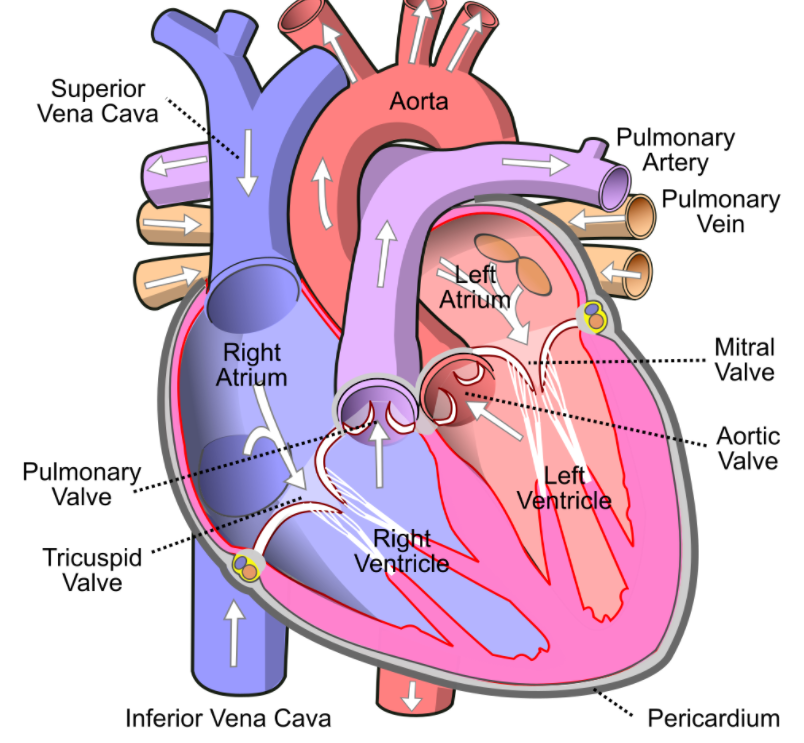
Write a note on the pericardium.
Answer
512.7k+ views
1 likes
Hint: The heart fits within a fluid-filled cavity called the pericardial cavity. The walls and lining of the pericardial cavity are a special membrane known as the pericardium. The parietal pericardium consists of an outer fibrous connective tissue sac lined by serosa.
Complete answer: 1. The pericardium is a type of serous membrane that produces serous fluid to lubricate the heart and prevent friction between the ever beating heart. Besides lubrication, the pericardium serves to hold the heart in position and maintain a hollow space for the heart to expand into when it is full.
2. The pericardium is a double-walled structure, made up of an outer fibrous layer and an inner serous layer.

3. It keeps your heart fixed in place within your chest cavity.
It prevents your heart from stretching too much and overfilling with blood.
4. It lubricates your heart to prevent friction with the tissues around it as it beats. It protects your heart from any infections that might spread from nearby organs like the lungs.
5. The fibrous pericardium is the outer layer. It’s made from thick connective tissue and is attached to your diaphragm. It holds your heart in place in the chest cavity and protects from infections.
6. Serous pericardium is the inner layer. It’s further divided into two more layers: the visceral and parietal layers. The serous pericardium helps to lubricate your heart.
In between these two layers is the fluid-filled pericardial cavity.
It lubricates the heart and protects it from injury.
Pericardial effusion is the buildup of too much fluid between the pericardium and your heart. This can happen from damage or disease in the pericardium.
Fluid can also build up if there’s bleeding.
7. A pericardial cyst is a noncancerous, fluid-filled growth in the pericardium. This type of cyst is very rare, affecting only 1 in 100,000 people.
Note: A severe pericardial effusion may need to be drained. The fluid is drained with a procedure called pericardiocentesis. This procedure uses a needle and a thin, flexible tube (catheter) to drain the fluid. In some cases, the pericardial sac may be drained during surgery.
Complete answer: 1. The pericardium is a type of serous membrane that produces serous fluid to lubricate the heart and prevent friction between the ever beating heart. Besides lubrication, the pericardium serves to hold the heart in position and maintain a hollow space for the heart to expand into when it is full.
2. The pericardium is a double-walled structure, made up of an outer fibrous layer and an inner serous layer.

3. It keeps your heart fixed in place within your chest cavity.
It prevents your heart from stretching too much and overfilling with blood.
4. It lubricates your heart to prevent friction with the tissues around it as it beats. It protects your heart from any infections that might spread from nearby organs like the lungs.
5. The fibrous pericardium is the outer layer. It’s made from thick connective tissue and is attached to your diaphragm. It holds your heart in place in the chest cavity and protects from infections.
6. Serous pericardium is the inner layer. It’s further divided into two more layers: the visceral and parietal layers. The serous pericardium helps to lubricate your heart.
In between these two layers is the fluid-filled pericardial cavity.
It lubricates the heart and protects it from injury.
Pericardial effusion is the buildup of too much fluid between the pericardium and your heart. This can happen from damage or disease in the pericardium.
Fluid can also build up if there’s bleeding.
7. A pericardial cyst is a noncancerous, fluid-filled growth in the pericardium. This type of cyst is very rare, affecting only 1 in 100,000 people.
Note: A severe pericardial effusion may need to be drained. The fluid is drained with a procedure called pericardiocentesis. This procedure uses a needle and a thin, flexible tube (catheter) to drain the fluid. In some cases, the pericardial sac may be drained during surgery.
Latest Vedantu courses for you
Grade 11 Science PCM | CBSE | SCHOOL | English
CBSE (2025-26)
School Full course for CBSE students
₹41,848 per year
Recently Updated Pages
Master Class 12 English: Engaging Questions & Answers for Success

Master Class 12 Social Science: Engaging Questions & Answers for Success

Master Class 12 Chemistry: Engaging Questions & Answers for Success

Master Class 11 Computer Science: Engaging Questions & Answers for Success

Master Class 12 Biology: Engaging Questions & Answers for Success

Master Class 12 Physics: Engaging Questions & Answers for Success

Trending doubts
The minimum age prescribed for election as a member class 10 social science CBSE

What is the full form of POSCO class 10 social science CBSE

Show that the points 11 52 and 9 5 are collinear-class-10-maths-CBSE

Difference between mass and weight class 10 physics CBSE

Identify the following with the help of map reading class 10 social science CBSE

What is the past participle of wear Is it worn or class 10 english CBSE




